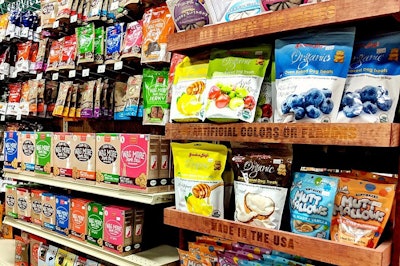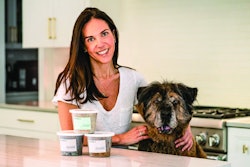
“No artificial flavoring or coloring” has been a popular pet food claim for more than a decade now, to the point that it’s almost a given that pet foods don’t include such ingredients. In fact, this type of “free from” claim seems to have been far eclipsed by others such as non-GMO, gluten free (rather inexplicable for pets) and, the mother of them all, grain free. (Even if that juggernaut took a hit from the U.S. Food and Drug Administration’s DCM investigation/debacle.)
Thus, it’s curious that a recent analysis from NielsenIQ calls out the “free from artificial flavors” claim as a missed opportunity for pet food brands. The context, apparently, is that it emerged as a commonly searched-for claim or attribute for pet products on Amazon.com from spring 2020 to summer 2021, though this specific attribute did not appear on a chart from NiesenIQ showing the largest increases in searches on the e-commerce giant. Those were for low-calorie, frozen, “diabetic support,” seafood ingredient and organic pet food.
‘Free from’: large market, but outdated as pet food claim?
The unidentified NielsenIQ analyst frames the “no artificial flavoring” claim as an example of a “golden opportunity to translate consumers’ increasingly specific health and wellness standards for their pets into more personalized offerings, simply by claiming characteristics for which shoppers are already searching.”
In other words, according to this theory, pet food brands could attract more consumer attention, and possibly sales, by using this particular “free from” claim. “Only 28% of pet products make a ‘free from artificial flavors’ claim, but 94% of products within the space actually qualify for that claim,” the blog post reads. “With more robust product attribute data that could guide on-package claims, qualifying products can avoid being eclipsed in online searches and overlooked in-store, and missing out on millions of dollars within the US$5.5 billion ‘free from artificial flavors’ space.
True, US$5.5 billion is a large market segment, though there is no context or other information provided for that data point. Yet, considering just how focused today’s pet owners are on health and wellness for their pets—a continually growing trend for quite a few years now—I think this example may be somewhat outdated or simplistic.
Six years ago, in 2015, “artificial ingredient free” ranked fifth among select “free from” claims that Packaged Facts posed to U.S. dog and cat owners as to whether they were a draw when shopping for pet food. Not surprisingly, grain free/gluten free combined for the top spot; still, only 19% of dog owners and 15% of cat owners classified it as a draw. Non-GMO came in second for dog owners (19%) and tied for third with corn free for cat owners (13%), with no fillers/by-products second for cat owners (17%) and tied for third, with corn free, for dog owners (18%). Only 15% of dog owners and 12% of cat owners said “artificial ingredient free” was a draw.
In July 2020, on a similar ranking of pet food attributes from Packaged Facts, “no artificial flavoring” didn’t even make the list.
Point of entry, not pet food differentiator
Again, I think the lack of artificial flavors or colors in pet food has become an expectation, even a point of entry, rather than a differentiator for consumers or brands. Hence, the 94% of pet products that would qualify for making such a claim, according to NielsenIQ. With space for claims at a premium on pet food packaging and online product pages, given all the other information required plus terms and images geared to attract consumers’ attention and imagination, I can understand why most pet food brands choose to prioritize other types of claims.
As the NielsenIQ analysis points out, consumers have become increasingly “conscious pet parents,” a mindset heightened even further by the pandemic. Yet, pet owners caring about their pets’ health and wellness is nothing new; nor is humanization, “applying their human wellness standards when shopping for their furry friends.” This analyst for NielsenIQ possibly needs to catch up with today’s sophisticated pet owners (and pet food market).
The analyst’s secondary point—that pet food brands should know and heed the pet product attributes pet owners are searching for online—does ring true. So, it makes sense to pay attention to the terms that garnered the most increases from April 2020 to March 2021: low-calorie, frozen, seafood ingredient and organic pet food. It’s difficult to know exactly what the “diabetic support” term means, but it’s likely an important clue that more pet owners are concerned about their pets developing or living with diabetes.

















